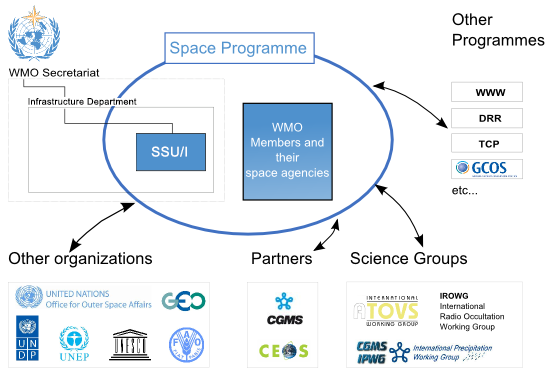WMO Space Programme Overview
Structure and Governance
The WMO Space Programme is supported by the WMO Space Systems and Utilization Division (SSU), which acts as the WMO focal point for satellite matters and maintains active relationship with a number of programmes and international bodies in this area. SSU is part of the Infrastructure Department WMO Integrated Global Observing Systems Branch (WIGOS).
WMO Members contribute to the WMO Space Programme through the activities of their respective space agencies and through the work of their experts and training centres.
Governance
The Commission for Observation, Infrastructure and Information Systems (INFCOM) has the lead role for the WMO Space Programme, in consultation with the Commission for Weather, Climate, Water and Related Environmental Services and Applications (SERCOM) and the Research Board on Weather, Climate, Water and the Environment (Research Board). INFCOM leadership relies on WMO Member technical expertise provided primarily through the Standing Committee on Earth Observing Systems and Monitoring Networks (SC-ON) and its Expert Team on Space Systems and Utilization (ET-SSU) and Joint Expert Team on Earth Observing System Design and Evolution (JET-EOSDE). The SC-ON makes recommendations to INFCOM. INFCOM reports to the WMO Executive Council through the report of the president of INFCOM.
A formal dialogue is established with meteorological and environmental satellite agencies through the WMO Consultative Meetings on High-level Policy on Satellite Matters (CM), which provide advice and guidance on policy-related matters and maintain a high-level overview of the WMO Space Programme.

Illustration 1: Visualization of the Governance Structure
Within SC-ON ET-SSU is specifically addressing satellite matters.
ET-SSU
The Expert Team on Space Systems and Utilization (ET-SSU) is composed of representatives of space agencies contributing to the WMO Integrated Global Observing System (WIGOS) and satellite data users from WMO members.
More information about ET-SSU (including terms of reference, membership, past meetings documents) is available via the following link.
Relations with partners
As a cross-cutting programme, the Space Programme works in connection with the different WMO or co-sponsored programmes it is responding to, such as World Weather Watch (WWW), Disaster Risk Reduction Programme (DRR), Tropical Cyclone Programme (TCP) or Global Climate Observing System (GCOS).
The Space Programme maintains close cooperation with the Coordination Group for Meteorological Satellites (CGMS) and its four science groups: the International A-TOVS Working Group (ITWG), the International Precipitation Working Group (IPWG), the International Radio-Occultation Working Group (IROWG) and the International Winds Working Group (IWWG). It also cooperates with the Committee for Earth Observations Satellites (CEOS), the Group on Earth Observations (GEO) and its Global Earth Observation System of Systems (GEOSS). Regular relationship is maintained with United Nations system organizations through the Office for Outer Space Affairs (OOSA) and the Committee on Peaceful Uses of Outer Space (COPUOS).

(Updated February 2022)
